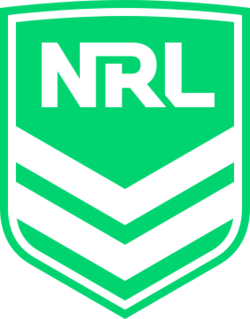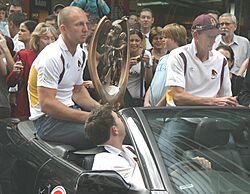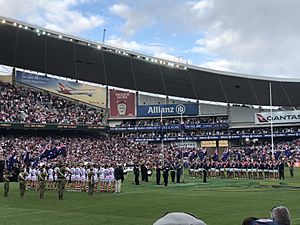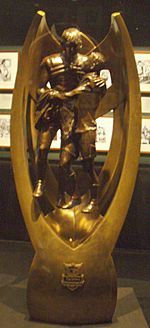National Rugby League facts for kids
 |
|
| Sport | Rugby league |
|---|---|
| Founded | 1998 |
| Inaugural season | 1998 |
| CEO | Andrew Abdo |
| No. of teams | 17 |
| Country | (16 teams) (1 team) |
| Headquarters | Rugby League Central, Sydney, New South Wales |
| Current premiers | (6th title) |
| Most premiers | |
| TV partner(s) | Australia: Nine Network Fox League New Zealand: Sky Sport Prime |
| Streaming partner(s) | Kayo Sports (Australia) 9Now (Australia) WatchNRL (Overseas) |
| Sponsor(s) | Telstra |
| Level on pyramid | Level 1 |
| International cup(s) | World Club Challenge |
| Related competitions |
New South Wales Cup Queensland Cup |
The National Rugby League (NRL) is the top professional rugby league competition in Oceania. It features teams from New South Wales, Queensland, Victoria, the Australian Capital Territory, and New Zealand. For sponsorship reasons, it's also called the NRL Telstra Premiership.
The NRL's story began with the New South Wales Rugby League, which started way back in 1908. Over the years, the competition changed a lot. A major event was the Super League war in the 1990s, a big disagreement that split the sport. In 1998, the two sides came together to create the NRL.
The NRL season usually runs from March to October. Each of the 17 teams plays 24 games. The team that finishes first after all these games wins the minor premiership. After that, the top eight teams play in a finals series. The season ends with the Grand Final, where the two best teams fight to become champions. The winning team then gets to play against the English Super League champions in the World Club Challenge.
The current champions are the Penrith Panthers. They won their sixth title in 2024, which was also their fourth win in a row.
History of the NRL
How it all Started
Rugby league in Australia began with the New South Wales Rugby League (NSWRL) in 1908. For many years, it was mainly a Sydney-based competition. Things started to change in the 1980s. The exciting State of Origin series began, and teams from outside Sydney, like the Canberra and Illawarra teams, joined the league.
In 1988, more teams joined, including the Brisbane Broncos and Newcastle Knights. These new teams were very popular and showed that fans all over the country loved rugby league. This led to the idea of a truly national competition.
The Super League War
In the mid-1990s, a big media company, News Corporation, wanted to create its own rugby league competition with pay television. This started the "Super League war." It was a fight for control of the sport and its broadcast rights.
For a year, there were two separate leagues: the traditional Australian Rugby League (ARL) and the new Super League. This split the teams, players, and fans. Many clubs struggled financially.
Finally, the two sides agreed to join forces. In 1998, they created the National Rugby League (NRL), bringing the best teams from both competitions together. The first NRL season had 20 teams.
A New Era for Rugby League
The early years of the NRL saw some big changes. To make the competition stronger, the league decided to reduce the number of teams to 14 by the year 2000. Some clubs merged to survive, like the St. George Dragons and Illawarra Steelers, who became the St. George Illawarra Dragons.
The 1999 NRL Grand Final set a world record for attendance at a rugby league game, with 107,999 fans watching the Melbourne Storm win.
In 2002, the South Sydney Rabbitohs, one of the original clubs from 1908, were brought back into the competition after being controversially cut. This was a huge moment for their passionate fans.
Growing Popularity
From 2003 to 2010, the NRL became more popular than ever. Crowds grew, and more people watched the games on TV. In 2007, the Gold Coast Titans joined the league, bringing a team back to the Gold Coast.
The year 2008 marked 100 years of rugby league in Australia. To celebrate, the NRL held special events all year. A "Team of the Century" was named, honouring the greatest players of all time.
However, this period also had its challenges. The Melbourne Storm were found to have broken the salary cap rules (the limit on how much teams can pay players). As a result, they were stripped of their 2007 and 2009 premiership titles.
The ARL Commission Takes Charge
In 2012, a new group called the Australian Rugby League Commission (ARLC) was formed. This independent group now runs the entire sport, from local clubs to the NRL.
The 2010s saw some amazing Grand Finals. In 2014, the South Sydney Rabbitohs won their first premiership in 43 years. The 2015 Grand Final is often called one of the greatest ever, with the North Queensland Cowboys winning in a thrilling golden-point finish.
In 2018, the NRL launched a national women's competition, the NRLW, which has become very successful.
Recent Years and Expansion
The 2020 and 2021 seasons were affected by the COVID-19 pandemic. The NRL had to pause the competition but was one of the first sports in the world to safely return to play.
In 2023, the NRL expanded to 17 teams with the addition of the Dolphins from Brisbane. The league has plans to keep growing. A team from Perth is set to join in 2027, and a team from Papua New Guinea will join in 2028, making the competition even bigger.
NRL Teams
The NRL has 17 clubs from across Australia and New Zealand. Nine teams are from the Sydney area. There are no divisions, so all teams compete in one big league.
Current Clubs
| Club | Location | Home Stadium | Premierships | |
|---|---|---|---|---|
| Total | Last Won | |||
| Brisbane, QLD | Suncorp Stadium | 6 | 2006 | |
| Canberra, ACT | GIO Stadium | 3 | 1994 | |
| Sydney, NSW | Accor Stadium | 8 | 2004 | |
| Sydney, NSW | Sharks Stadium | 1 | 2016 | |
| Brisbane, QLD | Suncorp Stadium | 0 | — | |
| Gold Coast, QLD | Cbus Super Stadium | 0 | — | |
| Sydney, NSW | 4 Pines Park | 8 | 2011 | |
| Melbourne, VIC | AAMI Park | 4 | 2020 | |
| Auckland, NZ | Go Media Stadium | 0 | — | |
| Newcastle, NSW | McDonald Jones Stadium | 2 | 2001 | |
| Townsville, QLD | Queensland Country Bank Stadium | 1 | 2015 | |
| Sydney, NSW | CommBank Stadium | 4 | 1986 | |
| Sydney, NSW | CommBank Stadium | 6 | 2024 | |
| Sydney, NSW | Accor Stadium | 21 | 2014 | |
| Sydney & Wollongong, NSW | Netstrata Jubilee Stadium & WIN Stadium | 1 | 2010 | |
| Sydney, NSW | Allianz Stadium | 15 | 2019 | |
| Sydney, NSW | Leichhardt Oval & Campbelltown Sports Stadium | 1 | 2005 | |
Future Clubs
The NRL is growing! Two new teams are scheduled to join the competition soon.
| Club | Expected Debut | Location | Home Stadium |
|---|---|---|---|
| 2027 | HBF Park | ||
| 2028 | Sir Hubert Murray Stadium |
How the Season Works
Pre-Season
Before the main season starts, clubs play trial matches in February and early March to prepare. There are also special pre-season events:
- All Stars Match: An exciting game between the Indigenous All Stars and the Māori All Stars.
- World Club Challenge: A match between the NRL champions and the English Super League champions to see who is the best club in the world.
Premiership Season
The main season, called the premiership, runs from March to September. Teams play 27 rounds of games.
- A win gets a team 2 competition points.
- A draw gets 1 point.
- A loss gets 0 points.
The team with the most points at the end of the 27 rounds is called the minor premier.
There are also special themed rounds during the season, like ANZAC Round to honour soldiers, and Magic Round, where all the games are played in one city over a single weekend.
Finals Series

After the regular season, the top eight teams on the ladder play in the finals. The finals are a four-week tournament in September. Teams are knocked out until only two are left.
These two teams then play in the NRL Grand Final. This is the biggest game of the year and decides who wins the premiership. The Grand Final is a huge event, usually held at Stadium Australia in Sydney in front of over 80,000 fans.
Major Awards
- Provan-Summons Trophy: This is the main prize. The winning team of the Grand Final gets to lift this famous trophy.
- J. J. Giltinan Shield: This is awarded to the minor premiers, the team that finishes first on the ladder after the regular season.
- Clive Churchill Medal: Given to the best player in the Grand Final.
- Dally M Medal: Awarded to the best and fairest player of the entire season. It is the highest individual honour a player can win.
- The Immortals: This is a special honour given to only the greatest players in the history of the game. There are currently only 14 Immortals.
Amazing NRL Records
Team Records
- Most Premierships: 21, South Sydney Rabbitohs.
- Most Premierships in a Row: 11, St. George Dragons (from 1956 to 1966).
- Highest Score in a Game: 91 points, St. George vs. Canterbury in 1935.
- Longest Winning Streak: 19 games, Sydney Roosters (1975) and Melbourne Storm (2021).
Individual Records
- Most Games Played: 430, Cameron Smith.
- Most Points Scored: 2,810, Cameron Smith.
- Most Tries Scored: 212, Ken Irvine.
- Most Tries in a Season: 38, Dave Brown in 1935.
Images for kids
Error: no page names specified (help).
- List of National Rugby League stadiums
- Rugby league in Australia
- NRL Women's Premiership
See also
 In Spanish: National Rugby League para niños
In Spanish: National Rugby League para niños






